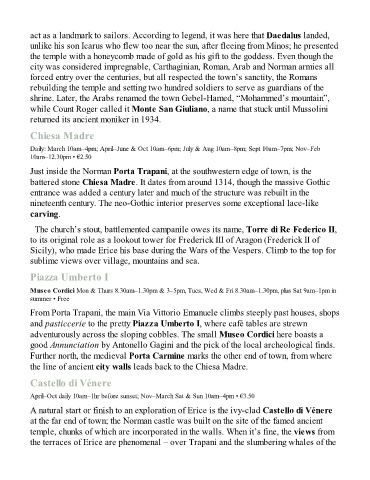Page 502 - The Rough Guide of Sicily
P. 502
act as a landmark to sailors. According to legend, it was here that Daedalus landed,
unlike his son Icarus who flew too near the sun, after fleeing from Minos; he presented
the temple with a honeycomb made of gold as his gift to the goddess. Even though the
city was considered impregnable, Carthaginian, Roman, Arab and Norman armies all
forced entry over the centuries, but all respected the town’s sanctity, the Romans
rebuilding the temple and setting two hundred soldiers to serve as guardians of the
shrine. Later, the Arabs renamed the town Gebel-Hamed, “Mohammed’s mountain”,
while Count Roger called it Monte San Giuliano, a name that stuck until Mussolini
returned its ancient moniker in 1934.
Chiesa Madre
Daily: March 10am–4pm; April–June & Oct 10am–6pm; July & Aug 10am–8pm; Sept 10am–7pm; Nov–Feb
10am–12.30pm • €2.50
Just inside the Norman Porta Trapani, at the southwestern edge of town, is the
battered stone Chiesa Madre. It dates from around 1314, though the massive Gothic
entrance was added a century later and much of the structure was rebuilt in the
nineteenth century. The neo-Gothic interior preserves some exceptional lace-like
carving.
The church’s stout, battlemented campanile owes its name, Torre di Re Federico II,
to its original role as a lookout tower for Frederick III of Aragon (Frederick II of
Sicily), who made Erice his base during the Wars of the Vespers. Climb to the top for
sublime views over village, mountains and sea.
Piazza Umberto I
Museo Cordici Mon & Thurs 8.30am–1.30pm & 3–5pm, Tues, Wed & Fri 8.30am–1.30pm, plus Sat 9am–1pm in
summer • Free
From Porta Trapani, the main Via Vittorio Emanuele climbs steeply past houses, shops
and pasticcerie to the pretty Piazza Umberto I, where café tables are strewn
adventurously across the sloping cobbles. The small Museo Cordici here boasts a
good Annunciation by Antonello Gagini and the pick of the local archeological finds.
Further north, the medieval Porta Carmine marks the other end of town, from where
the line of ancient city walls leads back to the Chiesa Madre.
Castello di Vénere
April–Oct daily 10am–1hr before sunset; Nov–March Sat & Sun 10am–4pm • €3.50
A natural start or finish to an exploration of Erice is the ivy-clad Castello di Vénere
at the far end of town; the Norman castle was built on the site of the famed ancient
temple, chunks of which are incorporated in the walls. When it’s fine, the views from
the terraces of Erice are phenomenal – over Trapani and the slumbering whales of the

